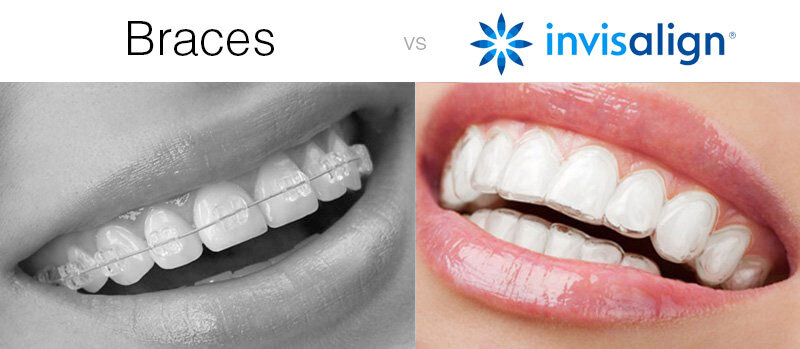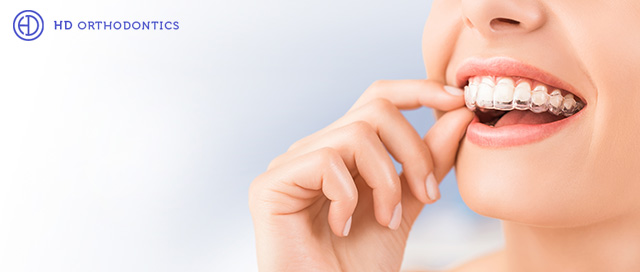Invisalign vs. Traditional Dental braces: Which Choice Is Right for You?
When thinking about orthodontic treatment, the selection between Invisalign and standard dental braces offers numerous vital variables that merit mindful examination. Invisalign provides a very discreet alternative with removable aligners, while standard braces offer a much more visible yet reliable remedy for extreme misalignment.
Summary of Therapy Options

On the other hand, typical dental braces contain metal brackets and cords that are bonded to the teeth. This method applies constant pressure with time to attain positioning. While reliable for intricate orthodontic problems, traditional braces call for regular brows through for changes and can pose difficulties in keeping oral hygiene as a result of the trouble of cleaning around brackets and cords.
Both choices have their values, and the option typically rests on particular dental problems, way of life choices, and individual compliance. Ultimately, seeking advice from an orthodontic expert is important for figuring out the most suitable therapy strategy tailored to individual demands. Understanding the subtleties of each alternative can considerably influence the general success of orthodontic therapy.
Visual Factors To Consider
A significant aspect affecting the choice between Invisalign and standard dental braces is the visual allure each therapy supplies. Invisalign aligners are crafted from clear plastic, making them virtually unseen when worn.
In contrast, conventional dental braces contain metal brackets and cords, which can be a lot more recognizable. While improvements in orthodontic modern technology have actually caused the development of smaller sized braces and tinted elastics, conventional braces still preserve a more conspicuous profile. For some individuals, the visibility of dental braces might deter them from looking for essential therapy.
Ultimately, the option between Invisalign and typical braces may rest on personal preferences pertaining to appearances. People who prioritize discernment frequently lean toward Invisalign, while those that are much less worried about exposure might choose for standard braces. Recognizing the visual effects of each option is vital for making an informed decision that aligns with one's lifestyle and preferences.
Comfort and Convenience

In terms of comfort, Invisalign aligners are removable, allowing clients to enjoy their favored foods without restriction and preserve optimum dental hygiene. Brushing and flossing are streamlined, as the aligners can be obtained during these routines, whereas typical dental braces need careful maneuvering around braces and wires.
In comparison, standard braces require regular changes, making them less hassle-free for those with busy schedules. Overall, the convenience and convenience of Invisalign make it an enticing choice for several people looking for orthodontic therapy.
Therapy Duration and Efficiency
While both Invisalign and typical dental braces work in correcting dental misalignments, the period of therapy can differ significantly in between both options. Generally, Invisalign therapy can take anywhere from 12 to 18 months, depending upon the intricacy of the situation. The clear aligners function by progressively moving teeth right into their preferred placements, and normal follow-ups with an orthodontist assistance ensure progression continues to be on course.
On the other hand, conventional dental braces usually call for a longer dedication, normally varying from 18 months to three years. This is because of their set nature and the usage of braces and cords, which can be a lot more effective for intricate cases and severe misalignments (Invisalign). The therapy effectiveness of standard braces is well-documented, as they enable exact Bonuses modifications and greater control over tooth motion
Eventually, the choice in between Invisalign and traditional braces may depend upon both the awaited treatment duration and the details dental issues handy. Consulting with an orthodontist is critical, as they can give customized suggestions based on individual requirements, guaranteeing the picked technique aligns with desired results and timeframes.
Cost Contrast and Insurance Coverage Alternatives
Cost plays a considerable role in the decision-making procedure for individuals considering orthodontic treatment, whether going with Invisalign or standard braces. Usually, the price of Invisalign varieties from $3,000 to $8,000, while conventional dental braces usually cost in between $2,000 and $6,000. Factors influencing these costs include the intricacy of the situation, the duration of treatment, and geographical place.
Lots of dental insurance plans supply partial protection for orthodontic treatments, yet the specifics can differ widely. Usually, typical dental braces may be a lot more regularly covered by insurance policy plans compared to Invisalign, which some insurance companies classify as an aesthetic procedure.
Additionally, numerous orthodontic methods supply adaptable layaway plan, making both treatment options more available. People must ask about potential financing options and discounts for in advance payments. Evaluating the total price, consisting of insurance benefits and settlement plans, is important for making an informed choice that aligns with both visual choices and budget considerations.

Final Thought
In recap, the selection in between Invisalign and conventional dental braces pivots on numerous factors, consisting of visual choices, convenience, therapy period, and cost. Invisalign supplies a very discreet, removable option that facilitates oral health and nutritional versatility, while conventional dental braces might be preferable for intricate dental read here issues and usually come at a reduced rate factor. Eventually, consultation with an orthodontist is vital to examine specific circumstances and determine the most proper treatment choice for attaining ideal dental alignment.
When thinking about orthodontic treatment, the choice between Invisalign and conventional dental braces offers a number of essential factors that merit mindful evaluation.Contrasting Invisalign and conventional dental braces reveals distinctive treatment choices for orthodontic correction.While both Invisalign and conventional braces are efficient in correcting oral imbalances, the duration of therapy can differ considerably between the 2 options.Cost plays a considerable duty in the decision-making procedure for people taking into consideration orthodontic treatment, whether choosing for Invisalign or conventional braces.In summary, the choice visit site in between Invisalign and traditional dental braces hinges on numerous elements, including visual choices, comfort, therapy period, and price.